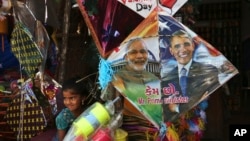Security and defense ties between India and the United States are set to get a boost when U.S. President Barack Obama heads to New Delhi on Sunday for his second visit since taking office.
The relationship had drifted in recent years but acquired fresh momentum after India Prime Minister Narendra Modi took office last year.
When tanks roll down the street and soldiers march in the Indian capital at the annual parade to mark the country’s Republic Day on Monday, an American president will be chief guest for the first time.
At the heart of the pageantry lies a demonstration of India’s military prowess. Some analysts are noting the symbolism.
Defense pact
During Obama’s visit, both countries are expected to renew a decade-old defense cooperation pact that ends this June.
C. Raja Mohan at the Observer Research Foundation in New Delhi expects the two sides to lay the foundation for a "genuine strategic partnership" with a broad set of agreements.
Mohan said Modi wants to build closer ties with Washington, which Indian leader visited four months ago.
"We are going to see greater commitment on both sides now to expand military-to-military cooperation, to begin serious technology transfer and co-production arrangements as well as look over to working together in the region," Mohan said.
"You have a government here in Delhi that is prepared to walk the full distance with the U.S. and U.S., too, has sensed the new opportunity in India," he added.
Defense trade and cooperation has been increasing rapidly.
In 2013, Washington edged out Russia as the largest arms supplier to India, which is spending billions of dollars to modernize its armed forces.
New Delhi conducts more joint military exercises with the U.S. than with any other country.
Both sides have also been scrambling to finalize agreements that could pave the way for U.S. companies to produce some military equipment in India.
Rahul Bedi with Jane’s Defense Weekly in New Delhi said tentative steps are being taken in this direction.
"One is to manufacture hand-held drones and the other is for intelligence surveillance and reconnaissance equipment to be placed aboard the Hercules transport aircraft that India acquired from the U.S. some years ago," Bedi said.
"Both sides are feeling their way because these are highly complex issues and there is a lot of bureaucracy involved not only in the U.S., but also in India," he added.
Technology agreements
New Delhi wants American companies to produce more weapons at home under technology transfer agreements as it tries to build an indigenous defense industry.
But there are many hurdles. The United States has strict controls on transfer of sensitive technology, while India is reluctant to sign pacts needed to acquire these technologies.
Experts said that while it will take time to build trust in a host of areas, broader security issues are driving India and the U.S. closer.
Chintamani Mahapatra at the School of International Studies at New Delhi’s Jawaharlal Nehru University cited worries on both sides about a more assertive China, a potentially unstable Afghanistan after withdrawal of Western troops, and the rise of the Islamic State group.
"Indians and Americans have been quarrelling over economic issues, IPR (intellectual property rights) issues, dumping issues, etc., etc., and of course on critical areas of foreign affairs like Pakistan, China, and Iran, the two countries do not agree 100 percent," Mahapatra said.
"But in matters of defense and security cooperation there is hardly any dispute. The idea is to have a good, positive win-win balance of power in Asia," he added.
But not everyone is optimistic. The relationship had drifted in recent years and just a year ago it hit a low point amid an outcry over an Indian diplomat’s arrest in New York.
Lowered expectations
Security analyst Bharat Karnad at New Delhi’s Center for Policy Research sai he does not expect concrete outcomes from the visit, and thinks India is unlikely to be satisfied with what Washington may offer on technology transfers of military equipment, such as coproduction of drones.
"As I see it, it is going to be more platitudes, more instruments being created, more committees being set up, but nothing really there on the ground in terms of both countries being satisfied with something substantive and hefty," Karnad said.
During his first visit to India in 2010, President Obama told Indian lawmakers that the relationship between the two countries will be the "defining partnership of the 21st century."
That potential has not been tapped in recent years. The jury is still out on whether that will happen as he visits for the second time -- but there is optimism that the visit will re-energize ties.




